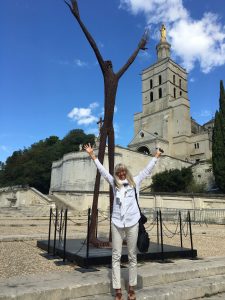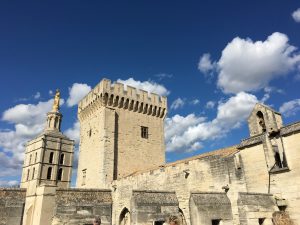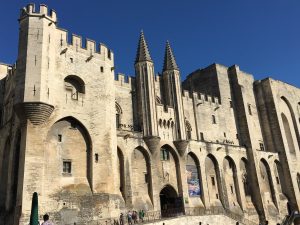After two wonderful weeks at La Bastide dans Le Luberon, the beautiful and very French country house of Tim and Danielle, it was time to get back on the road and continue my journey. For the next 4 days Kimberly is with me (yay!), so I can share my explorations and adventures with a friend. First stop, Avignon.
One cannot visit Avignon without a walk along the Pont D’Avignon, if nothing else but to remember and hum the nursery rhyme “Sur la Pont, d’Avignon, On y danse, On y danse…” The bridge spans the Rhône between Villeneuve-lès-Avignon and Avignon and was built between 1177 and 1185. This early bridge was destroyed forty years later when Louis VIII of France laid siege to Avignon. The bridge was rebuilt with 22 stone arches. It was very costly to maintain as the arches tended to collapse when the Rhône flooded. Eventually in the middle of the 17th century the bridge was abandoned. There are 4 remaining arches which jut out into the river, and simply end in the middle. It is a UNESCO site despite not reaching the other side.
To understand Avignon is really to know the history of the politics of the time within the Catholic Church. Distressed by factionalism in Rome and pressed to come to France by Philip IV, Pope Clement V moved the papal capital to Avignon, which at that time belonged to vassals of the pope. In 1348 it became direct papal property. The Avignon papacy was overwhelmingly French, all seven of the popes during the period were French, as were 111 of the 134 cardinals created. Then, in the year 1378, the Roman Catholic Church split when the King of France decided that he did not like the Italian Pope and elected one of his own. The Great Schism, as it has been called, lasted for about 68 years, during which time there were two popes claiming authority over the Catholic Church.
While the Church was ruled from Avignon, the Palace of the Popes (also a UNESCO site) was built over the course of 20 years in the mid 1300’s and remains today as a symbol of that time. It has served as an army barracks and so was largely renovated to return it to it’s early glory. The “Indulgence Window” had to be re-created — it’s where the Pope would bestow his blessings on the crowd below. It is now a tourist destination, and occasional space for art exhibits. The huge empty rooms make for good backdrops for large sculpture especially — what was there when we visited was art from various African artists.
Next to the Palace is the Metropolitan Cathedral of Notre Dame des Doms Avignon, which served as the mother church of the diocese of Avignon, consecrated in 1475. The most spectacular part of it is the huge bronze Jesus on top, which almost glows in the sunlight. The interior is interesting mostly for all the side chapels, and the paintings on the interior of the dome. There were some nuns and French schoolgirls (or novices) visiting when I was walking through — perfect.
While strolling back to the hotel after dinner we discovered the Opera House, which was beautiful all lit up. And behind it, the Bellfroi d’Avignon, a spiky gothic site that has been above the town hall for centuries. And that was Saturday.



















Everyday there seems to be even more stunning architecture than the day before.
Can one walk onto the abandoned span?